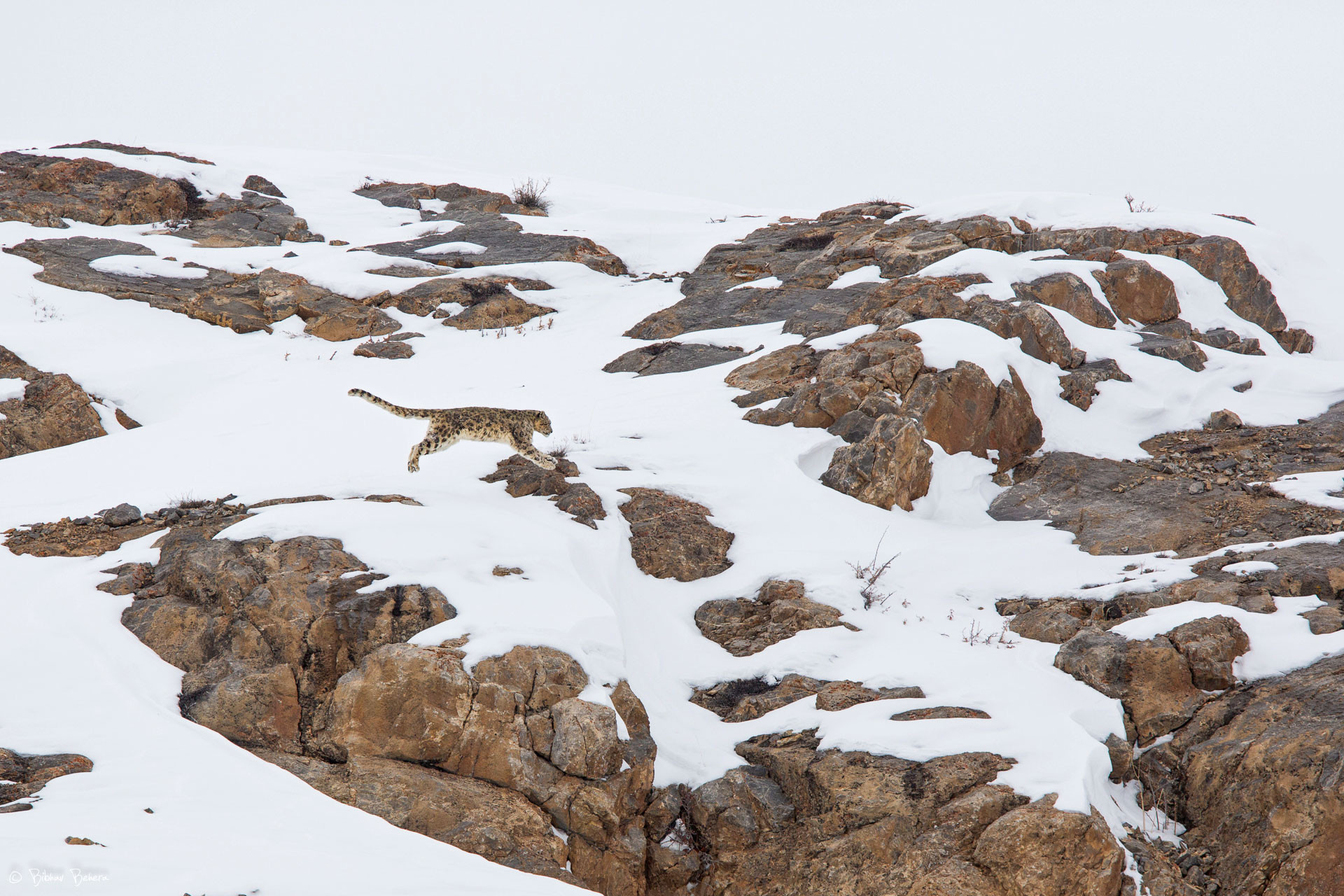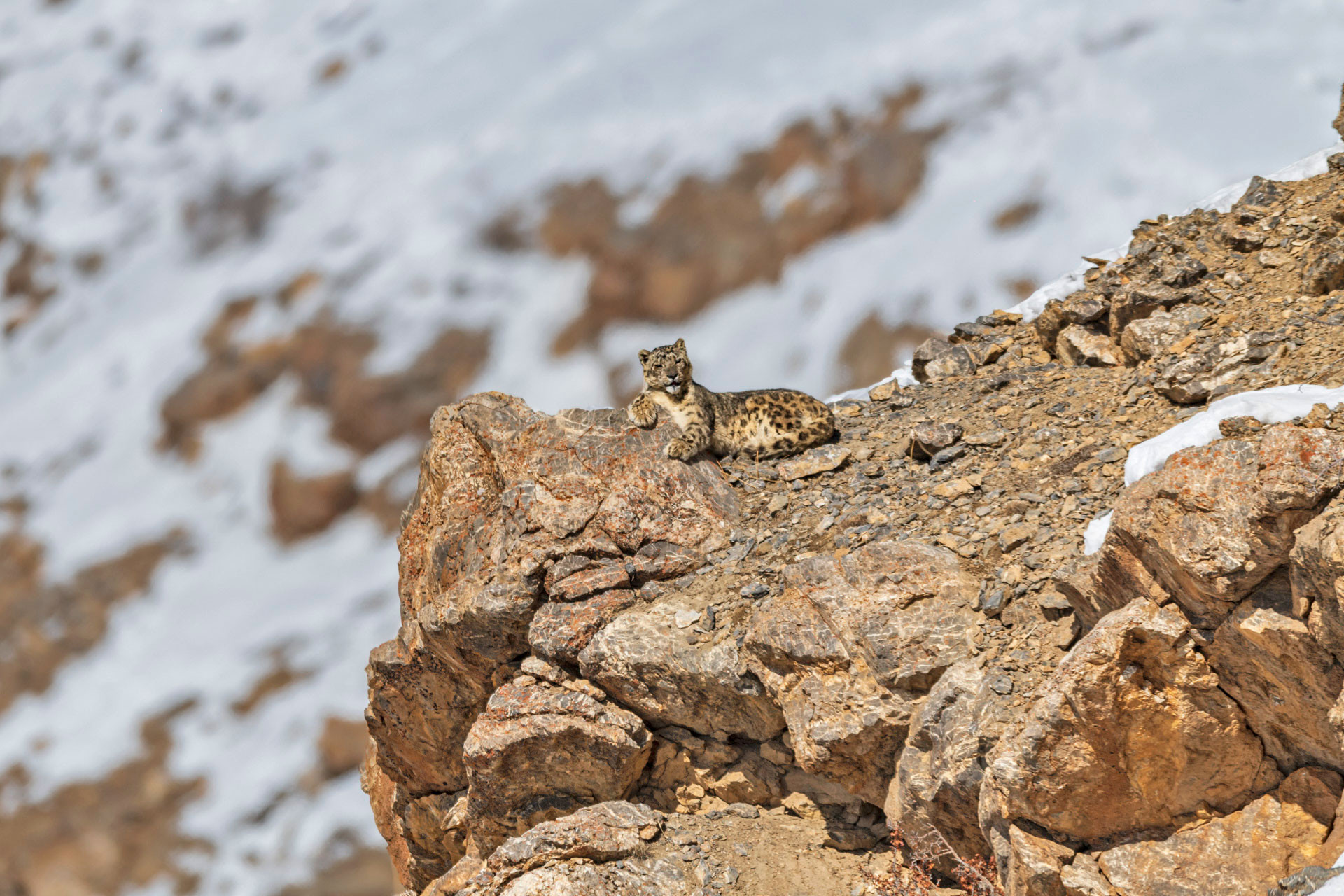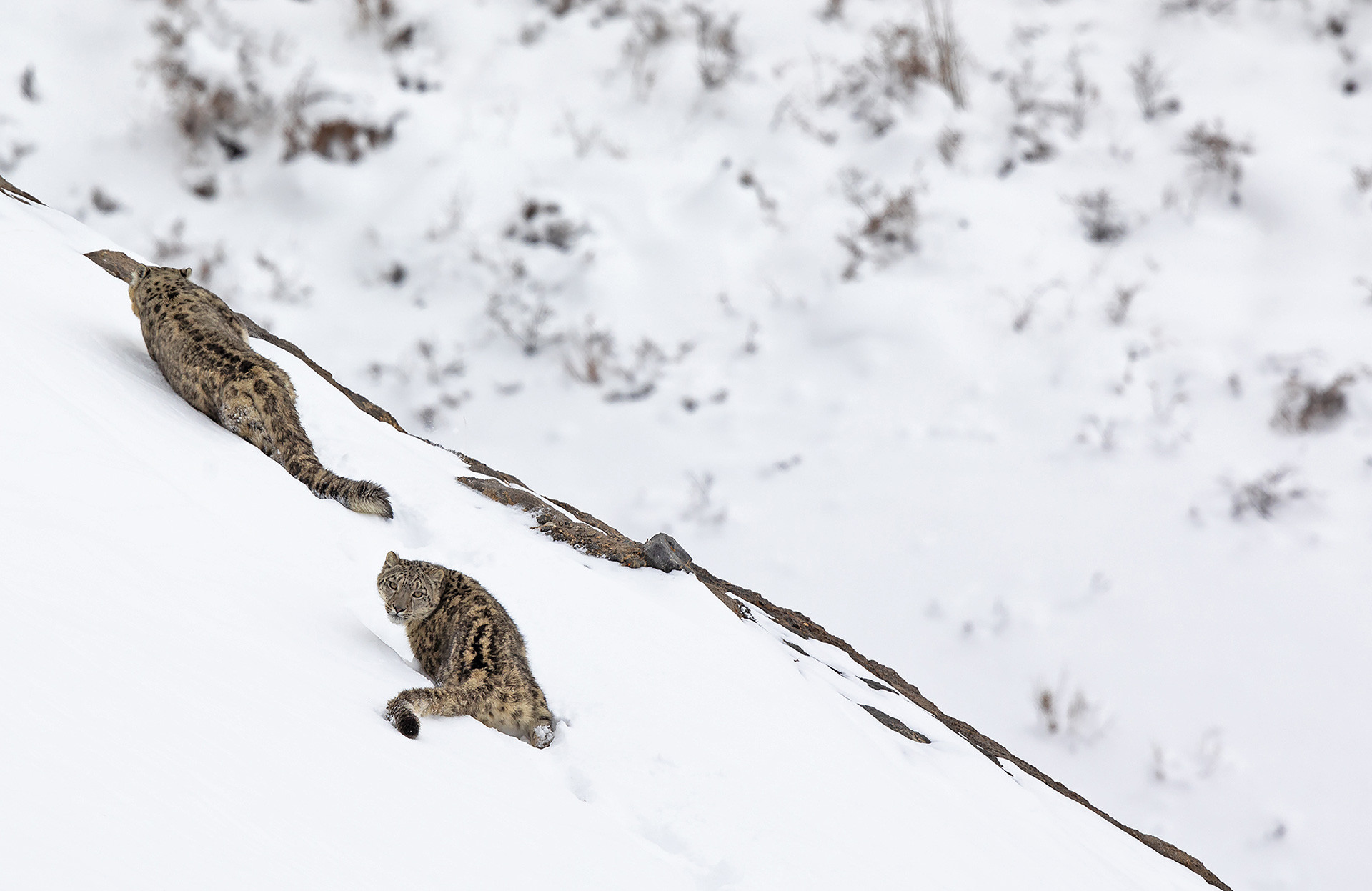On every wildlife photographer's wishlist is the Snow Leopard.
Trudging through the uplands, they wait for hours in freezing temperatures for that one picture-perfect moment when they can document the presence of this mesmerising animal. And even after all the effort, the felid sometimes decides to play hooky right in front of their eyes!
For centuries, the Snow Leopard has captivated the imagination of humans, fueled by the aura of the mysterious cats that call the mountains home. Among the members of the Wakhi community, an ethnic group native to South and Central Asia, the Snow Leopard is referred to as the Pes, which is also a term for a supernatural being that has striking features, is powerful and rarely interacts with the humans. In Tibet, the Snow Lion is a celestial animal that portrays strength, joy and fearlessness. Not too far from the truth?
In this story, we bring you ten essential facts about the felid that has mastered the art of living in the mountains; jumping over rocky ravines and walking on deep snow. Here is a peek into the world of the Snow Leopard.
1—Living in the High Abode
The grey ghost of the Himalayas, the SHEN, the king of the snow-capped mountains and one of the most elusive cats in the world; the Snow Leopard (Panthera uncia) belongs to the large cat family alongside the tiger, lion, leopard and jaguar. But if you are looking for a trademark roar, you will be disappointed as they are the only members in the family who cannot roar. Snow Leopards are thought to inhabit around 2 million sq.km. of area across the Central and South Asian mountains—the Indian Himalayas being one of their most important habitats. They inhabit these precipitous terrains between 500 and 5800m and are well-adapted to the constant freezing temperatures. They prefer rocky mountains and steep ravines.
2—Where's Waldo?
Whitish-grey coats with dark grey and black rosettes, Snow Leopards camouflage exceptionally well against their rocky surroundings. “Nine out of ten times you encounter this spectacular cat, you think you are gazing at a stationary rock before the slightest movement makes you realise that you are witnessing one of the most charismatic species of the Himalayas,” writes wildlife photographer Shivang Mehta.
Snow Leopards measure about 90–130cm in length and weigh about 35–55kg. Female leopards weigh less than males. Snow Leopards have distinct pale grey or green eyes and extremely long tails, sometimes measuring as long as a metre.
3—Did Someone Say it's Cold?
Did you know that they are capable of jumping six times the length of their body? Several morphological features arm the Snow Leopard for a life in the mountains. They have long fur to protect them from the cold. The fur length is about 5cm throughout the body except for the belly, where it is longer. They also have wide paws that enable them to walk over rocky surfaces and on deep snow. Additionally, their front legs are shorter, which helps them to manoeuvre the hilly landscape easily. Their long tails provide them with balance, and when it gets cold, they use it as a cover.
“The cat was at ease in the mountains, taking its own time to navigate its way. Often, it would stop to evaluate a drop or a climb and see if there was an alternative way around,” writes wildlife photographer Shreeram MV while describing the life of The Grey Ghost Of The Himalayas.
4—Counting Sheep
Snow Leopards are predators, and the three main species that form their prey base include the Blue Sheep or Bharal, Ibex and the Argali sheep—a wild sheep species found in East Asia, the Himalayas and Tibet. The Snow Leopards that reside in the Himalayas mainly prey on the Blue Sheep and the Himalayan Ibex. Being opportunistic hunters, Snow Leopards also feed on livestock, large birds and other mammal species. They wait patiently for the right opportunity before launching an attack on their prey. The captured and killed animal is eaten over the next three to four days, and Snow Leopards guard their hunt carefully, restricting their movements close to the kill site. They hunt for their next prey only after eight or ten days.
5—Cubs on the Prowl
Solitary animals, Snow Leopards are only found in pairs or groups during the mating season or when the cubs accompany their mother. The mating season for Snow Leopards coincides with late winter, and they use scratch marking, scent rubbing or leaving urine or faecal droppings to announce their presence to a potential mate. The female leopard delivers 2-3 cubs after a gestation period of 90-100 days. Born in a den, the cubs open their eyes after seven days and begin hunting lessons at three months. Snow Leopard cubs accompany their mother for almost two years before they go on to lead solitary lives.
6—How Little We Know
Snow Leopards are the only large cats that reside in the cold mountainous regions of Asia. The home range of an individual leopard can be as extensive as 100sq.km. A lot of this includes areas that are typically inaccessible. The solitary nature of Snow Leopards combined with their vast territories makes it difficult to ascertain the population of a region. According to snowleopard.org, the global Snow Leopard population ranges between 3,500 and 7,000, while IUCN predicts there are anywhere between 2,710 and 3,386 extant mature individuals. Estimates for India range between 400 and 500 individuals. Population estimates have been made using camera studies, scat analysis, questionnaires and surveying signs of leopard existence. Researchers believe that the data we have now only covers 1.5 per cent of the actual Snow Leopard range globally.
7—A Decade of Loss
Snow Leopards are designated as Vulnerable on the IUCN Red List, and their population is decreasing worldwide. A range of threats imperils the species in India, including human encroachment of their habitats, reduction of prey base, retaliatory killings and poaching. India is among the five range countries that together contribute to 90 per cent of the global poaching incidents. Snow Leopards are poached for their skin and claws, and between 1993 and 2012, there has been a 61 per cent increase in Snow Leopard trades worldwide compared to the previous decade.
8—A Changing Climate
A significant looming threat for Snow Leopard populations is global warming. According to a 2012 study by the WWF, continued greenhouse gas emissions could lead to a 30 per cent decrease in the habitat of Himalayan Snow Leopards. Impacts of climate change are both direct and indirect, as shown by wildlife biologist Munib Khanyari. “In recent years, erratic snowfall has led to a decrease in pasture productivity in an already low productivity system. This is affecting the health of livestock in a region dominated by agro-pastoralist communities. Herders are venturing further and higher in search of pasture, which often results in their livestock coming into proximity and thus competition with wild prey,” writes Khanyari while observing the Snow Leopard population in the Upper Kinnaur region in Himachal Pradesh.
9—Education, Conservation & Reparation
Several conservation efforts are already underway to protect Snow Leopards across geographies. Snow Leopard Trust and the Nature Conservation Foundation (NCF) work to understand the felid's population through genetic and camera research while also collecting data on the ecology of the big cats. Using eco-camps, the organisation educates children and adults about the importance of Snow Leopards. Additionally, through livestock insurance programs, the Snow Leopard Trust provides compensation for livestock loss through predation, leading to reduced incidents of retaliatory killing. NCF has also worked with the residents of the Sumdoo TR village in eastern Ladakh, building predator-roof corrals to protect the livestock. Additionally, the organisation initiated the ‘SHEN’ conservation program in 2013, a women-led handicraft enterprise that empowers women in the Kibber region while encouraging conservation efforts.
10—Where to Start?
Snow Leopards are vital creatures for their habitats. Being apex predators, they keep a check on the population of animals such as the Himalayan Tahr, Blue Sheep and Ibex, maintaining an ecological balance. They also ensure that the herbivore population is in check, protecting the grasslands of the region. A healthy Snow Leopard count in the Himalayas is indicative of healthy mountains and healthy rivers that stem from them. This is why we all must educate ourselves on Snow Leopards and the dangers that surround them.
We may live miles away from their abodes, but we can spread the message and extend support for organisations working on Snow Leopard conservation. Wondering where to start? How about here!













